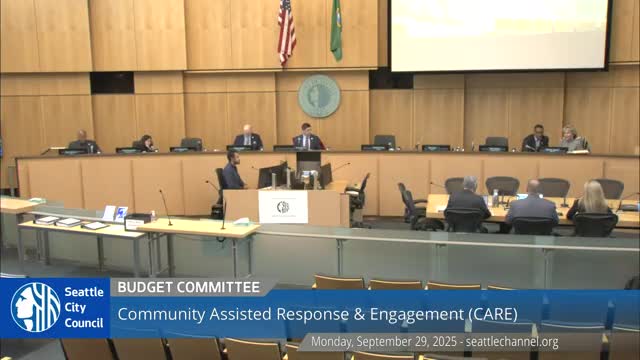Seattle Care department seeks staff and dispatch expansion to cover more 911 calls
September 30, 2025 | Seattle, King County, Washington
This article was created by AI summarizing key points discussed. AI makes mistakes, so for full details and context, please refer to the video of the full meeting. Please report any errors so we can fix them. Report an error »

Seattle’s Care department chief, Amy Barton, told the City Council’s Select Budget Committee on Sept. 29 that the department needs 49 new positions and expanded dispatch capacity to respond to the rising number of 911 calls tied to mental health, homelessness and addiction.
Barton said the budget request would add 31 responders to operate citywide 20 hours a day, 15 staff for Seattle 911 to reduce wait times, and other business supports. “We have tested and proven the safety and the utility of dispatching care responders to 911 calls,” Barton said. She added that many 911 calls rarely result in law‑enforcement action and argued that unarmed community responders can deliver the same or better results at lower cost.
The department cited performance metrics to justify the expansion. Barton said hold time for high‑priority 911 calls is under 15 seconds 93 percent of the time and that current nonemergency wait time averages 4 minutes, 18 seconds. By contrast, she said the Seattle Police Department’s response time to many lower‑priority calls can average 173 minutes.
Barton and staff referenced a Seattle University evaluation of the Care pilot (January–December 2024) that analyzed 1,585 calls and recommended five items, including resolving labor disputes that affect Care, removing bureaucratic barriers, closing follow‑up case‑management gaps, expanding to 24/7 service and clearer public messaging about the CCR role. Barton said she also sits on national working groups and has reviewed other jurisdictions’ models, such as Albuquerque’s ACS.
Council members asked for details on how Care will integrate with existing providers, how the department will ensure follow‑up case management, and what legal or operational steps are needed before Care can be solo‑dispatched. Barton emphasized an outstanding need for a formal MOU with Seattle Police to enable full solo dispatching and said Care is exploring closer links with the 988 crisis line and with jail and hospital reentry pathways so Care can intercept people at high risk.
Barton also said the department lacks in‑house analytics staff to publish a public dashboard and that much of the available Care and RMS data has been shared with researchers; she asked council offices to consider funding dedicated analytics capacity. Several council members said they wanted performance metrics and regular reports when expansion funds are spent.
The discussion remained at the policy and budget level; committee members did not take a formal vote during the hearing.
Looking ahead: the department’s expansion depends on approval of the mayor’s budget and subsequent council budget actions, plus progress on any MOU that would permit Care to be regularly dispatched without a police co‑response.
Barton said the budget request would add 31 responders to operate citywide 20 hours a day, 15 staff for Seattle 911 to reduce wait times, and other business supports. “We have tested and proven the safety and the utility of dispatching care responders to 911 calls,” Barton said. She added that many 911 calls rarely result in law‑enforcement action and argued that unarmed community responders can deliver the same or better results at lower cost.
The department cited performance metrics to justify the expansion. Barton said hold time for high‑priority 911 calls is under 15 seconds 93 percent of the time and that current nonemergency wait time averages 4 minutes, 18 seconds. By contrast, she said the Seattle Police Department’s response time to many lower‑priority calls can average 173 minutes.
Barton and staff referenced a Seattle University evaluation of the Care pilot (January–December 2024) that analyzed 1,585 calls and recommended five items, including resolving labor disputes that affect Care, removing bureaucratic barriers, closing follow‑up case‑management gaps, expanding to 24/7 service and clearer public messaging about the CCR role. Barton said she also sits on national working groups and has reviewed other jurisdictions’ models, such as Albuquerque’s ACS.
Council members asked for details on how Care will integrate with existing providers, how the department will ensure follow‑up case management, and what legal or operational steps are needed before Care can be solo‑dispatched. Barton emphasized an outstanding need for a formal MOU with Seattle Police to enable full solo dispatching and said Care is exploring closer links with the 988 crisis line and with jail and hospital reentry pathways so Care can intercept people at high risk.
Barton also said the department lacks in‑house analytics staff to publish a public dashboard and that much of the available Care and RMS data has been shared with researchers; she asked council offices to consider funding dedicated analytics capacity. Several council members said they wanted performance metrics and regular reports when expansion funds are spent.
The discussion remained at the policy and budget level; committee members did not take a formal vote during the hearing.
Looking ahead: the department’s expansion depends on approval of the mayor’s budget and subsequent council budget actions, plus progress on any MOU that would permit Care to be regularly dispatched without a police co‑response.
View full meeting
This article is based on a recent meeting—watch the full video and explore the complete transcript for deeper insights into the discussion.
View full meeting
